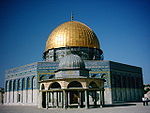- Solomon's Stables
-
Solomon's Stables (Hebrew: אורוות שלמה) or Marwani Mosque is an underground mosque some 600 square yards (500 square meters) beneath al-Aqsa Mosque in Jerusalem. Solomon's Stables are located under the southeastern corner of the Temple Mount, 12½ metres below the courtyard and feature twelve rows of pillars and arches.
Contents
History
The mosque was initially a water reservoir that had been built by the Roman Emperor Hadrian in the second century, along with the stone wall currently surrounding al-Aqsa Mosque. Its overall structure closely resembles that of the Roman Ramla reservoir with stone pillars and junctions. That the reservoir was built at the same time as the wall is evident since the southern and eastern walls of the reservoir are a continuation of the wall surrounding al-Aqsa Mosque. Instead of an addition built long after the wall, the reservoir was built at the same time, as can be inferred from the joining of the stones.
The reservoir was used to collect water flowing into it from surrounding areas, through horizontal aqueducts made of stone and feeding into vertical canals in the external walls of the reservoir. One of these vertical canals can still be seen today and is located at the level of the main entrance of the Marwani mosque. It is semi-circular and is lined with a Roman fuller of limestone mixed with ground clay and sand. The flooring of the reservoir is made of stone, but is covered with layers of silt that have accumulated over the years.[1]
During the Umayyad reign, this reservoir was converted into a mussalah and was named the Marwani Mussalah, by the Islamic Umayyad Khalifa, Abd al-Malik ibn Marwan, along with the Dome of the Rock.[2] It remained so until the Crusaders converted it in 1099 into a stable for the infantry. The rings for tethering horses can still be seen on some of the pillars. The place used to be accessed from the single-panel gate located in the southern wall of al-Aqsa Mosque, which is also the southern wall of the Marwani mussalah.
The structure was called Solomon's Stables during Crusader times as a historical composite. 'Solomon's' refers to the First Temple which the Crusaders believed to be built on the site, while the 'stables' refers to the functional usage of the space by the Crusaders in the time of Baldwin II (King of Jerusalem 1118-1131 CE).[3]
Modern construction
In 1996, the waqf restored the mosque there, with a capacity for 7,000 worshipers.
 The Southern Wall of the Temple Mount showing damaged area and criticized repair job as a bright white patch to right.[original research?]
The Southern Wall of the Temple Mount showing damaged area and criticized repair job as a bright white patch to right.[original research?]
Artifacts
The soil removed from the dig was dumped near the Mount of Olives and a salvage operation, the Temple Mount Antiquities Salvage Operation was undertaken in order to sift through the debris for archaeological remains. Many important finds have turned up.[4]
Popular culture
In popular culture, the area has become associated with the Knights Templar due to a claim in the 2003 novel The Da Vinci Code that the order maintained its headquarters here.
External links
References
- ^ http://www.isesco.org.ma/english/publications/Protection%20of%20islamic%20and%20chrestian%20holy%20sites%20in%20Palestine/p9.php
- ^ http://www.atlastours.net/holyland/al_aqsa_mosque.html
- ^ Linquist, J.M., The Temple of Jerusalem, Praeger, London, 2008, p.207
- ^ First Temple artifacts found in dirt removed from Temple Mount
Mosques in Israel and the Palestinian territories Israel al-Bahr Mosque • Hassan Bek Mosque • Jezzar Pasha Mosque • Mahmood Mosque • Mahmoudiya Mosque • Makam al-Nabi Sain Mosque • al-Muallaq Mosque • Sidna Ali Mosque • White Mosque (Nazareth) • White Mosque (Ramla)

East Jerusalem Abdeen Mosque • al-Aqsa Mosque • al-Khanqah al-Salahiyya Mosque • Marwani Mosque • Mosque of OmarWest Bank Great Mosque of Nablus • al-Hamadiyya Mosque • Jamal Abdel Nasser Mosque • al-Khadra Mosque • Ibrahimi Mosque • Nabi Yahya Mosque • an-Nasr Mosque • Mosque of Omar • Sultan Ibrahim Ibn Adham MosqueGaza Strip Great Mosque of Gaza • Ibn Marwan Mosque • Ibn Uthman Mosque • Sayed al-Hashim Mosque • Umm al-Naser Mosque • Welayat MosqueCategories: Israel, Palestine – Islam in Israel and the Palestinian territories – Mosques by country Islamic structures on the Temple Mount Mosque al-Aqsa Mosque • Marwani Mosque
Domes Dome of the Ascension • Dome of the Chain • Dome of al-Khidr • Dome of al-Khalili • Dome of Moses • Dome of the Muezzin • Dome of al-Nahawiyyah Dome of the Prophet • Dome of the Rock • Dome of Solomon • Dome of the Spirits • Dome of Yusuf • Dome of Yusuf AghaFountains Fountain of Ibrahim al-Rumi • Fountain of Qasim Pasha • Fountain of Qayt Bay • Fountain of Sha'lan • Fountain of Sultan Solomon • Pool of RaranjOther structures Islamic Museum • Mihrab Ali Pasha • Minbar of Buran al-DinMinarets See also Islamization of the Temple Mount • Jerusalem Islamic WaqfCoordinates: 31°46′34.92″N 35°14′13.24″E / 31.7763667°N 35.2370111°E
Categories:- Temple Mount
- Islamic architecture
- Mosques in Jerusalem
- Arabic architecture
- Knights Templar
- Classical sites in Jerusalem
- Medieval sites in Jerusalem
Wikimedia Foundation. 2010.


